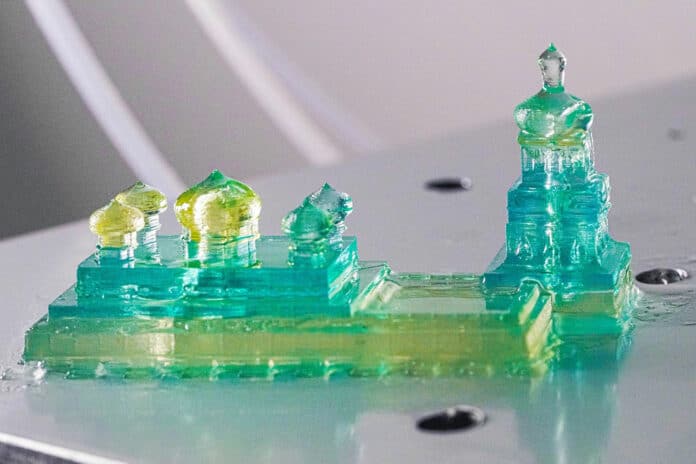
Recent advances in 3D printing have made it easier for designers and engineers to customize projects, create physical prototypes at different scales, and produce structures that can’t be made with more traditional manufacturing techniques. But the technology still faces limitations – the process is slow and requires specific materials which, for the most part, must be used one at a time.
Now, engineers at Stanford University have developed a method of 3D printing that promises to create prints faster, using multiple types of resin in a single object. Their design is 5 to 10 times faster than the quickest high-resolution printing method currently available and could potentially allow researchers to use thicker resins with better mechanical and electrical properties.
Already in 2015, researchers introduced continuous liquid interface production (CLIP), where a resin platform smoothly pulls the object, seemingly fully formed, from a thin pool of resin. The resin at the surface is hardened into the right shape by a sequence of UV images projected through the pool, while a layer of oxygen prevents curing at the bottom of the pool and creates a dead zone where the resin remains in liquid form. The liquid resin is supposed to fill in behind it, allowing for smooth, continuous printing. But this doesn’t always happen, especially if the piece rises too quickly or the resin is particularly viscous.
They now have mounted syringe pumps on top of the rising platform for the new technique, called injection CLIP (iCLIP), to add extra resin at key points.
“The resin flow in CLIP is a very passive process – you’re just pulling the object up and hoping that suction can bring material to the area where it’s needed,” says Gabriel Lipkowitz, lead author of the paper. “With this new technology, we actively inject resin onto the areas of the printer where it’s needed.”
The resin is delivered through conduits that are printed simultaneously with the design. The conduits can be removed after the object is completed, or they can be incorporated into the design the same way that veins and arteries are built into our own body.
The iCLIP presents the opportunity to print with multiple types of resin over the course of the printing process, where each new resin requires its own syringe. So far, they have tested the printer with up to three different syringes, each filled with resin dyed a different color.
“The ability to make objects with variegated material or mechanical properties is a holy grail of 3D printing,” Lipkowitz says. “The applications range from very efficient energy-absorbing structures to objects with different optical properties and advanced sensors.”
They are now working on software to optimize the design of the fluid distribution network for each printed part in order to have fine control over the boundaries between resin types. This could also potentially speed up the printing process even further.
Journal reference:
- Gabriel Lipkowitz, Tim Samuelsen, Kaiwen Hsiao, Brian Lee, Maria T. Dulay, Ian Coates, Harrison Lin, william Pan, Geoffrey Toth, Lee Tate, Eric S. G. Shaqfeh, and Joseph M. Desimone, Injection continuous liquid interface production of 3D objects. Science Advances, 2022; DOI: 10.1126/sciadv.abq3917
New 3D printing method is 10 times faster than the quickest printer
Source: Tambay News

0 Comments